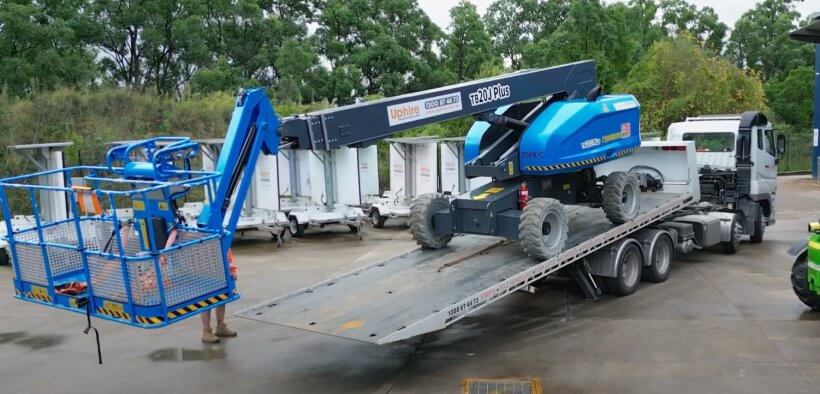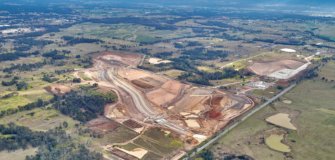Uphire shortlisted for IoT Awards with Inauro-optimised telemetry
Martin Sinclair Jun 05

The IoT Awards recognise the transformational impact of IoT (Internet of Things) on our economy and society. These awards are intended to celebrate those who are spearheading innovation and good practice.
Uphire has been developing telemetry on our machines with the help of Inauro, whom we started working with at the end of 2021. Inauro, specialising in automating workflows, has assisted Uphire in their mission to integrate the latest in technologies to supply more reliable, and smarter fleets.
Uphire has stood its ground against tough competition for over 12 years. An Australian SME, it leases access and construction equipment along with traffic control vehicles to tier-one builders, private projects and weekend hobbyists nationwide. To stay competitive in multiple client markets, there’s a constant need to streamline processes, monitor equipment and nurture client relationships.
The management team had used GPS to help keep track of its equipment and vehicles and was aware that IoT technology could further enhance operations. But without developers on staff to integrate the software, they were unsure how best to take advantage of the technology they knew could be a game changer for their business.
Keeping track of a large fleet requires a smart rental management system
Uphire’s clientele includes tier-one construction companies with multiple end users, sole traders and individuals requiring equipment for one-off projects.
Staying ahead of imminent breakdowns due to clients neglecting to charge equipment has been a key challenge. The biggest hurdle, however, has been receiving calls from clients complaining about faulty equipment and requesting service visits from technicians when, in fact, there had been neglect in charging the equipment before use.
“As a hire company, we always want to know where our fleet is, the condition of our equipment and what it’s doing,” says Uphire’s business services manager, Ilsa Walsh. “A successful equipment-hire business means your assets are out in the field being fully utilised, so there’s a considerable relationship management element to consider too.”
A secondary problem was clients disputing extra charges when a vehicle had exceeded the allowed kilometres stated in the contract.
“In our rental contracts, it says those vehicles can be driven 100km a day, or excess charges apply,” she says. “Previously, we didn’t have a method to find out if they were being used excessively and to track that back into our rental contracts.
“Our customers can request stand-down periods for wet weather or public holidays. That means it’s on hire, but we’re not charging them for those days. We needed a way to run reporting that could show us if the equipment on stand down was actually being used and then charge the customer.”
These problems were placing client relationships at risk and wasting company resources.
How Inauro seamlessly integrated Perspio without the need for an in-house tech team
Uphire knew the value of IoT technology and made enquiries with several companies. Inauro was the only option to offer the seamless integration and ease of use Uphire required.
“There was an aspiration from Uphire to try to use technology to differentiate themselves in the market,” says Inauro co-CEO and co-Founder Craig Kesby. “They were keen to look for ways to try and use technology both operationally and for efficiency and also to market that out to their customer base.”
The Inauro team began by assessing the company’s telemetry connectivity across all assets. Telemetry is the process of automatically recording performance data of any product at its source and transmitting it to a remote location, like a head office, for monitoring and analysis. Our modular data fusion platform, Perspio, can connect any field data source (telemetry or non-telemetry) and is a modular system that can be customised to suit the unique requirements of any business.
The next step was for the Inauro team to analyse the main use cases and implement the platform to address several operational inefficiencies. In the absence of an internal tech team at Uphire, it was essential for the entire process to be fast and simple and for the equipment management software to be easy to use.
Once Uphire began to use Perspio to its full potential, they saw immediate gains.
“A huge point of difference was that we were going to be able to use one interface through our existing fleet management solutions to see all our different devices,” says Ms Walsh. “They were able to demonstrate that to us before we signed with them.
“You don’t have to have people logging into a different portal for trucks and a separate portal for other machines. And that was really exciting to us, because we wanted to bring all our data together and make it as seamless as possible for the end users in our team. It has enabled us to better understand what’s going on with our fleet and customers.
“We can see our equipment in real-time and link it to invoicing, rental contracts and administration tasks — and we’re still building out the integration and evolving the way we use Perspio to suit our business needs.
“A lot of software companies say, ‘Oh, we can integrate,’ or ‘We have an outward-facing API.’ But we don’t have a team of developers at Uphire to help take us on that journey. Inauro’s platform has this out of the box and their software-development capability ensures we benefit from new discoveries or iterations without having to fill a skills gap to get the most out of the software.”
Inauro Chief Commercial Officer Max Girault says smaller companies sometimes fear that implementing something with the technological wizardry of Perspio will be difficult and time-consuming. But the opposite is true.
“It’s not complex for a company of any size to start leveraging this, and it doesn’t require a lot of time to implement,” says Mr Girault. “It’s not hard to deploy and start seeing benefits quickly.”
Mr Kesby adds: “A lot of companies probably have more of the building blocks already in place than they think. People don’t realise a lot of equipment today is coming with telemetry already in it, so the base requirements are already there to get them going.”
Hard data equals a better service and enhanced customer satisfaction
For Uphire, the benefits of working with Inauro come down to time and money saved due to a more efficient operational environment, greater confidence about the whereabouts and condition of all their assets and enhanced customer relationships.
“Perspio gives us fault usage information to help us respond to faults as they happen and even before they happen,” explains Ms Walsh. “In the case of battery units, we can identify if a customer has a machine that hasn’t been used or charged for an excessive period of time. With a quick phone call, or an automated text message, we can get in front of potential equipment breakdowns with a gentle reminder to plug the unit into a powerpoint. That establishes trust between Uphire and the customer.”
Using Perspio has also led to some unexpected benefits.
“We have been able to start generating some revenue that we wouldn’t have been able to before,” says Ms Walsh. “Previously, we didn’t have a method to find out if our vehicles were being used excessively and track it alongside our rental contracts. Now, we have a solution for that.
“If a customer gets an excess-kilometre charge, it can surprise them,” she continues. “Now, we’re able to say, ‘It looks like your driver did a 50km circle out of where he should have been.’ So we can educate customers a lot more about end-user behaviour.”
Further adding to profitability and efficiency has been a reduced need for service calls.
“If a customer has a flat battery and their machine won’t start, we can go in and check the charging history and say, ‘Well, this machine hasn’t been put on charge for three weeks. We can either send a technician out at your cost, or you can put it on charge for a full cycle and see if the problem is resolved.’ So it saves us sending out our technicians.”
All of this adds up to greater customer satisfaction.
“Our bigger customers hire equipment long-term, and those contracts are great for the company,” she says. “When you’re a hire company, you don’t want your fleet sitting around in the yard, so for us, it’s about providing the right service and building relationships where customers continue to use us for the equipment needs over a period of time. Those longer-term relationships are one of our key non-financial metrics of success.”
Taking the next steps to level up with Inauro
Uphire is now working with Inauro to build a series of customised dashboards for different roles in the business. For example, the service coordinator needs to see separate information to the transport allocator.
“The transport allocator will be able to see little red dots on all the machines that have finished their jobs and need to be picked up, whereas the service coordinator will be able to see machines with active faults or too many fault alarms and start proactively working on those.
“Inauro obviously know the hire industry very well, so they understand what our needs are going to be around our fleet and the problems that we want to solve,” says Ms Walsh. “So they have all the answers.”
Words of advice
Ms Walsh says the detailed data Perspio has enabled Uphire to give its clients has been a powerful asset, allowing them to move the company forward with greater confidence. Her advice to other companies considering implementing new technologies is to ask the right questions.
“Do your research,” she says. “If you want to make technology and telemetry work for you, you need to make sure you’re asking a lot of detailed questions, and you need to make sure you’re getting the answers you want.
“Don’t make any assumptions about what providers can do. That was a big lesson we learnt in talking to all the different providers. You’ve got to get into the specifics — does this system talk to that system? Where will the data go? What will it look like?
“And you don’t want to hear that it will take 12 to 18 months to develop a system,” she continues. “You want to hear that it’s coming out in the next four to six weeks. That’s what we’re getting with Inauro.”
To find out more about Inauro, visit www.inauro.io










